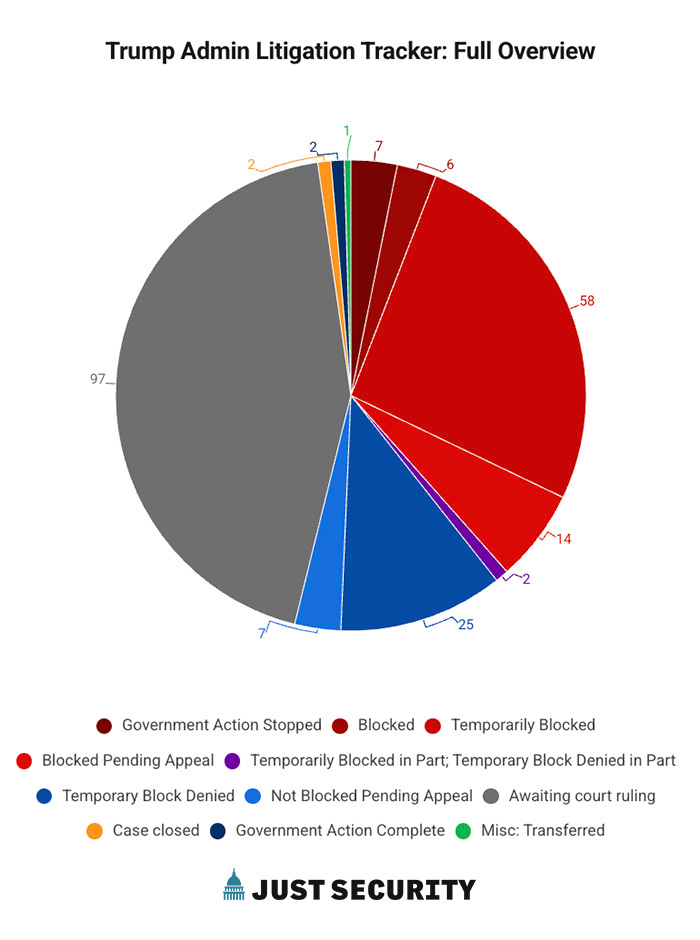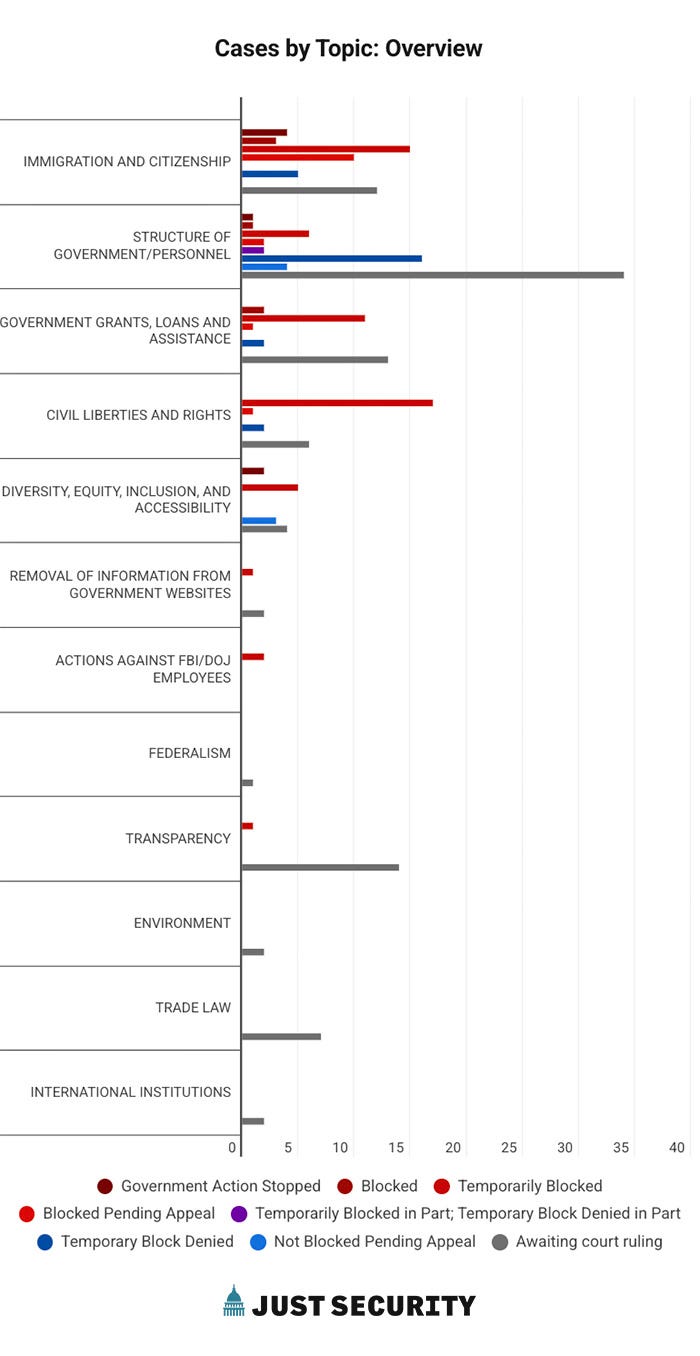100 Days | In the Know with Just Security’s Trump Administration Litigation Tracker
""At the 100 days mark, in cases where courts have issued a ruling, plaintiffs have succeeded over 71% of the time in blocking the government’s actions...."
We are monitoring every case against Trump administration executive actions in the Litigation Tracker over at justsecurity.org, and I will be drawing my own lessons here.
On a personal note, I have started a YouTube channel where I hope readers will subscribe and join the conversation there as well.
I. Litigation snapshot:
Tuesday marks the first 100 days of the Trump administration. The charts below show a snapshot of where litigation against the administration’s executive action stands.
At the 100 days mark, in cases where courts have issued a ruling, plaintiffs have succeeded over 71% of the time in blocking the government’s actions. Examples include getting the courts to issue a temporary restraining order, a preliminary injunction or a permanent one. These cases are represented by the slices of the pie with shades of RED.
At the 100 Days mark, news outlets may report widely variating totals of how many cases have been filed since January 20th. We are careful not to overcount. Here are three notes we have recently added to the Litigation Tracker:
Note-1: We treat as one case all the lawsuits involving the removal of F-1 foreign student visa registration. According to Politico, there were “more than 100 lawsuits and 50 restraining orders from dozens of federal judges,” before the government reversed its decision and restored the F-1 registrations on or about Apr. 25, 2025.
Note-2: We do not track cases in which the Trump administration is the plaintiff/files a civil lawsuit. Other organizations include those cases in their litigation trackers.
Note-3: We do not count appeals as separate cases. The appeal of a district court decision to the Court of Appeals and/or Supreme Court is part of the same case.
II. My key takeaway for today:
On Monday, we saw an extraordinary pushback by the DC Circuit against the administration’s plan to purge the Consumer Financial Protection Bureau’s (CFPB) workforce with a 90% reduction in staff. The outcome also involves a near miss for the Trump administration on contempt of court. Indeed, one might argue that the DC Circuit also saved the administration from that fate, or at least gave the White House another opportunity to avoid it.
Here’s the tiktok:
The case involves the potential dismantling of the CFPB: National Treasury Employees Union v. Russell Vought.
March 28: District Court Judge Amy Berman Jackson issued a preliminary injunction preventing the dismantling of the CFPB. One notable item is Provision 3 of that court order, which was written fairly broadly:
“Defendants shall not terminate any CFPB employee, except for cause related to the individual employee’s performance or conduct; and defendants shall not issue any notice of reduction-in-force to any CFPB employee.”
April 11: The DC Circuit upheld the preliminary injunction in significant part but also narrowed it in part. In narrowing Provision 3 in particular, the DC Circuit stated:
“Provision three (3) is stayed insofar as it prohibits defendants from terminating or issuing a notice of reduction in force to employees whom defendants have determined, after a particularized assessment, to be unnecessary to the performance of defendants’ statutory duties.” (emphasis added)
April 17-18: Plaintiffs submitted a motion to Judge Berman Jackson alleging that the administration was imposing a 90% reduction in CFPB staff and was thus in violation of both the district court and DC Circuit orders - since that en masse termination was neither a “particularized assessment” nor would it leave the CFPB able to perform its statutory duties. Judge Berman Jackson appeared to agree. She blocked the mass reduction in force (RIF) and scheduled hearings for today and tomorrow, April 29-30th. Those hearings were anticipated to be a showdown. In the meantime, the Trump administration appealed Judge Berman Jackson’s block on the 90% RIF.
On Monday, April 28: The same DC Circuit panel – this time in a 2-1 decision with Judge Gregory Kastas, a Trump appointee, joining the majority – rejected the Trump administration’s appeal. Remarkably, the majority took the unusual step sua sponte (“on its own accord”) to reinstate Provision 3 in full. The DC Circuit appeared to think, along the same lines as the district court, that the administration’s attempted 90% RIF was in violation of the courts’ orders. Those orders sought to essentially freeze matters in place while the litigation on whether the administration can legally dismantle the CFPB proceeds.
How does this get the administration off the hook from what might have ended up in contempt proceedings? So long as the administration complies with the new panel decision — and there’s no indication (yet) that it isn’t – the chances of gamesmanship or purposeful end-runs disappear. And now, with the backing of the DC Circuit’s expansive order on Provision 3, clearly prohibiting the administration’s attempted 90% RIF, Judge Berman Jackson called off the hearings that were set for today and tomorrow that might have ended in contempt proceedings.
III. Keep your eye on the ball:
We’re still playing a waiting game for two major Supreme Court decisions:
1. W.M.M. v. Trump - in which the Court temporarily froze the administration’s attempt to deport individuals from the Northern District of Texas under the purported authority of the Alien Enemies Act.
2. The twin NLRB cases - in which the Court may decide the scope of presidential power to remove the top officials from independent administrative bodies without congressional approval, a decision with significant implications for the independence of the Federal Reserve Board.
Stay tuned for “The Supreme Court’s Next 100 Days,” a great piece by Steve Vladeck at the Just Security site on Wednesday.
IV. From the mailbox:
I’ll be answering readers’ questions. Send me any questions on your mind about the ongoing litigation.
A reader asks: “Can we get the people already disappeared to El Salvador back? They had no due process so the whole thing is illegal. I want to know how the US can be forced to get them back.”
The Supreme Court has approved courts’ ordering the administration to facilitate the release of individuals detained in El Salvador (even though the Justice Department has since misquoted and mischaracterized that holding in the Abrego Garcia case). This past week a second district court judge, Judge Stephanie Gallagher, a Trump appointee, ordered the administration to facilitate the release of a 20-year old man who had been sent to El Salvador’s CECOT prison in violation of a court-administered settlement agreement.
One of the most important cases to watch now is the ACLU and Democracy Forward’s habeas petition on behalf of all the detainees held in CECOT prison who the U.S. administration sent there under a purported invocation of the Alien Enemies Act. I anticipate Chief Judge James Boasberg in that case will hold that the detainees remain in the “constructive custody” of the United States due to the administration’s agreement with El Salvador (which included payment of funds to El Salvador to hold detainees sent from the United States for one year). That would mean the district court has habeas jurisdiction to assess the legality of their detention there. And with the right to habeas corpus (literally to “produce the body” before the court) comes the ability for courts to compel the government to take all steps to get them released and returned to the United States.
In other contexts, the U.S. government has often sought to “moot out” cases alleging constructive custody before a court can rule that habeas corpus extends to a particular foreign location (by releasing or transferring the detainee plaintiff before the court can rule). But the Trump administration appears unlikely to follow that path, likely setting up a showdown that could likely lead to a very unfavorable result for their position. That said, it’s not clear whether the Supreme Court would agree with lower courts on this issue. Watch this space.
Thanks for reading. Make sure you check the Litigation Tracker regularly for updates and let us know if we’re missing anything.
Ryan






Thank you for your work. 🙏🏽
Are there any cases that challenge the validity of deporting someone resulting in their imprisonment in El Salvador even though the deportation itself may be proper? My limited understanding of deportation is removal from the country and not “rendition” to a country with which the deportee has no previous connection. In other words, what is the legal basis for sending purported Venezuelan gang members to a prison in El Salvador even if removal itself is legal either under immigration law or the Alien Enemies Act?